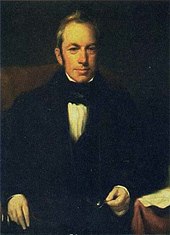Robert Brown (botanist, 1773)

Robert Brown (born December 21, 1773 in Montrose , Scotland , † June 10, 1858 in London , England ) was a Scottish doctor and an important botanist . Its official botanical author abbreviation is " R.Br. ".
Live and act
Robert Brown studied medicine and botany at the University of Edinburgh . In 1795 he was stationed in Ireland as a military doctor . He collected numerous plants there and met the London botanist Sir Joseph Banks , who enabled him to take part in a trip to Australia on a survey ship. Brown collected and studied almost 4,000 largely unknown plant species there from 1801 to 1805 . On his return he worked on this collection until 1810, finally published his results and then managed Joseph Banks' extensive collections of books and plants as a librarian at the Linnean Society . After Banks' death, his collections went to the British Museum , and Brown was appointed librarian and curator of the botanical collections. From 1849 to 1853, Brown was President of the Linnean Society and published numerous papers.
Brown's first floristic work consisted in the investigation of the mosses , which at that time were still very poorly researched. It became clear to him that precise histological- anatomical studies with the help of the microscope were very promising for the systematic classification of plants according to the natural system of Augustin-Pyrame de Candolle . This is how he made decisive discoveries about plant morphology . He recognized the fundamental differences in the structure of the ovules of conifers and cycads (Cycadophyta) compared to other higher plants and distinguished them as naked plants (gymnosperms) from flowering plants (Magnoliophyta). He also examined the development of ovules and thus distinguished for the first time integuments , nucellus and embryo sac as well as endosperm and perisperm .
While studying the fertilization process in orchids , he kept noticing a small body in the cells that others had already seen before him, but whose meaning they misunderstood. In 1831 Brown gave it the name Nucleus and gave it an important role in embryonic development . With this discovery of the cell nucleus , Brown influenced the botanist Matthias Jacob Schleiden, among others, and thus influenced the development of the cell theory .
The foundations for Brown's best-known discovery made in 1827 while using a microscope, the movement of minute particles suspended in liquid, called Brownian motion , extend beyond the field of botany and were only clarified in 1905 by Albert Einstein and in 1906 by Marian Smoluchowski .
Honors
In 1812 he was elected as a member ("Fellow") in the Royal Society , which in 1839 awarded him the Copley Medal . In 1818 he was elected a member of the Leopoldina Scholars' Academy and a foreign member of the Bavarian Academy of Sciences . In 1825 he became a Fellow of the Royal Society of Edinburgh . In 1842 he was accepted into the Prussian order Pour le Mérite for science and the arts . From 1812 he was also a member of the Prussian Academy of Sciences and from 1814 of the Académie des Sciences . In 1849 he was elected to the American Academy of Arts and Sciences . In his honor were the genera Brunonia Sm. Of the plant family of the Goodeniaceae , Brownetera Rich. ex Tratt. and Robertia Rich. ex Carrière from the family of stone slices (Podocarpaceae) and Brunoniella Bremek. from the acanthus family (Acanthaceae).
On May 29, 2018, an asteroid was named after him: (29210) Robertbrown .
literature
- Heinz-Peter Schmiedebach : Brown, Robert. In: Werner E. Gerabek u. a. (Ed.): Encyclopedia of medical history. De Gruyter, Berlin / New York 2005, ISBN 3-11-015714-4 , p. 213.
- Brown, Robert . In: Encyclopædia Britannica . 11th edition. tape 4 : Bishārīn - Calgary . London 1910, p. 661 (English, full text [ Wikisource ]).
- Friedrich Wilhelm Klatt : Norbert Brown. In: Eduard Otto (Ed.): Hamburger garden and flower newspaper. 14th year, Robert Kittler, Hamburg 1858, pp. 337–339
Web links
- Literature by and about Robert Brown in the catalog of the German National Library
- Author entry and list of the plant names described for Robert Brown (botanist, 1773) at the IPNI
- Entry to Brown; Robert (1773–1858) in the Archives of the Royal Society , London
Individual evidence
- ↑ Robert Brown: A brief account of microscopic observations made in the months of June, July and August 1827, on the particles contained in the pollen of plants; and on the general existence of active molecules in organic and inorganic bodies. In: Phil. Mag. A. Ann. of Phil. IV. September 1828, p. 16.
- ↑ Robert Brown's membership entry at the Bavarian Academy of Sciences , accessed on December 21, 2016.
- ^ Fellows Directory. Biographical Index: Former RSE Fellows 1783–2002. Royal Society of Edinburgh, accessed October 13, 2019 .
- ^ Orden Pour le Mérite for sciences and arts (ed.): The members of the order . tape 1: 1842-1881 . Gebr. Mann Verlag, Berlin 1975, ISBN 3-7861-6189-5 ( orden-pourlemerite.de [PDF; accessed on September 18, 2011]).
- ^ Members of the previous academies. Robert Brown. Berlin-Brandenburg Academy of Sciences , accessed on March 2, 2015 .
- ↑ Lotte Burkhardt: Directory of eponymous plant names . Extended Edition. Botanic Garden and Botanical Museum Berlin, Free University Berlin Berlin 2018. [1]
| personal data | |
|---|---|
| SURNAME | Brown, Robert |
| BRIEF DESCRIPTION | Scottish botanist |
| DATE OF BIRTH | December 21, 1773 |
| PLACE OF BIRTH | Montrose |
| DATE OF DEATH | June 10, 1858 |
| Place of death | London |